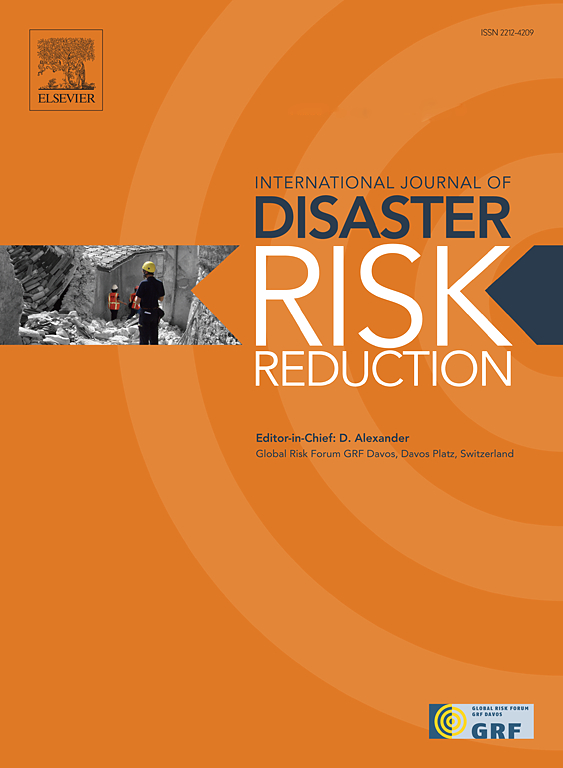Networks in crisis: Measuring ethnic stratification and organizational reach post-disaster
IF 4.2
1区 地球科学
Q1 GEOSCIENCES, MULTIDISCIPLINARY
International journal of disaster risk reduction
Pub Date : 2025-05-09
DOI:10.1016/j.ijdrr.2025.105561
引用次数: 0
Abstract
This study investigates the extent of ethnic stratification within social networks in a disaster-affected community. Prior research highlights disparities in resilience capacities across racial and ethnic groups, often attributed to social isolation and limited access to resources. Utilizing a novel survey of 240 residents in Farmburg, California (pseudonym), we analyzed individual and organizational network data to examine three key aspects of connectivity: 1) resident-to-resident ties, 2) resident-to-organization ties, and 3) organizational reach across ethnic groups. Findings reveal significant ethnic homophily in resident networks, with a predominance of intra-ethnic ties. Furthermore, the study identifies variations in the extent to which different types of organizations bridge these ethnic divides. Preliminary analysis suggests that healthcare and emergency response organizations may exhibit lower levels of inter-ethnic connectivity compared to other types of organizations. By quantifying these social divides and their impact on organizational reach, this study provides crucial insights for developing more equitable and inclusive disaster resilience strategies that effectively address the needs of all community members.
危机中的网络:衡量种族分层和灾后组织范围
本研究调查了受灾害影响的社区中社会网络中的种族分层程度。先前的研究强调了不同种族和族裔群体在恢复能力方面的差异,这通常归因于社会孤立和获得资源的机会有限。利用对加利福尼亚州法姆堡240名居民(化名)的新颖调查,我们分析了个人和组织网络数据,以检查连通性的三个关键方面:1)居民与居民的联系,2)居民与组织的联系,以及3)跨种族的组织范围。研究结果显示,居民网络中存在显著的种族同质性,种族内关系占主导地位。此外,该研究还确定了不同类型的组织在弥合这些种族分歧的程度上的差异。初步分析表明,与其他类型的组织相比,医疗保健和应急组织可能表现出较低的族裔间连通性。通过量化这些社会差异及其对组织影响力的影响,本研究为制定更公平、更具包容性的灾害恢复战略提供了重要见解,这些战略可有效满足所有社区成员的需求。
本文章由计算机程序翻译,如有差异,请以英文原文为准。
求助全文
约1分钟内获得全文
求助全文
来源期刊

International journal of disaster risk reduction
GEOSCIENCES, MULTIDISCIPLINARYMETEOROLOGY-METEOROLOGY & ATMOSPHERIC SCIENCES
CiteScore
8.70
自引率
18.00%
发文量
688
审稿时长
79 days
期刊介绍:
The International Journal of Disaster Risk Reduction (IJDRR) is the journal for researchers, policymakers and practitioners across diverse disciplines: earth sciences and their implications; environmental sciences; engineering; urban studies; geography; and the social sciences. IJDRR publishes fundamental and applied research, critical reviews, policy papers and case studies with a particular focus on multi-disciplinary research that aims to reduce the impact of natural, technological, social and intentional disasters. IJDRR stimulates exchange of ideas and knowledge transfer on disaster research, mitigation, adaptation, prevention and risk reduction at all geographical scales: local, national and international.
Key topics:-
-multifaceted disaster and cascading disasters
-the development of disaster risk reduction strategies and techniques
-discussion and development of effective warning and educational systems for risk management at all levels
-disasters associated with climate change
-vulnerability analysis and vulnerability trends
-emerging risks
-resilience against disasters.
The journal particularly encourages papers that approach risk from a multi-disciplinary perspective.
 求助内容:
求助内容: 应助结果提醒方式:
应助结果提醒方式:


